
Stapelia is a genus of low-growing, spineless, stem succulent plants, predominantly from South Africa with a few from other parts of Africa. Several Asian and Latin American species were formerly included but they have all now been transferred to other genera. The flowers of certain species, most notably Stapelia gigantea, can reach 41 cm (16 inches) in diameter when fully open. Most Stapelia flowers are visibly hairy and generate the odor of rotten flesh when they bloom.

The genus Huernia consists of perennial, stem succulents from Eastern and Southern Africa and Arabia, first described as a genus in 1810.

Stapelia gigantea is a species of flowering plant in the genus Stapelia of the family Apocynaceae. Common names include Zulu giant, carrion plant and toad plant. The plant is native to the desert regions of South Africa to Tanzania.
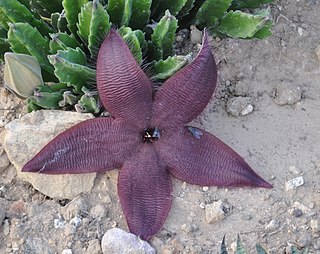
Stapelia grandiflora is a species of flowering plant in the genus Stapelia of the family Apocynaceae. It is commonly referred to as the carrion plant, starfish flower, giant toad plant, or starfish cactus, although it is not related to cacti at all. This "carrion plant" nickname can also refer to similar Stapelia species as well as members of related genera, including Stapelia gigantea and Orbea variegata. Stapelia grandiflora sometimes also goes by the name of Stapelia flavirostris. The plant is native to South Africa, including the Northern Cape, Eastern Cape, and Free State.

Moritz Kurt Dinter was a German botanist and explorer in South West Africa.

In botany, succulent plants, also known as succulents, are plants with parts that are thickened, fleshy, and engorged, usually to retain water in arid climates or soil conditions. The word succulent comes from the Latin word sucus, meaning "juice" or "sap".

Leslie Charles "Larry" Leach was a Rhodesian taxonomic botanist.

Oscularia deltoides, the deltoid-leaved dewplant, dassievygie or sandsteenvygie is a species of flowering succulent plant in the fig-marigold family Aizoaceae that is native to the south-western Cape, South Africa.

Kalanchoe pumila, the flower dust plant, is a species of flowering plant in the stonecrop family Crassulaceae, native to Madagascar. Growing to 20 cm (8 in) tall and 45 cm (18 in) wide, it is a spreading, dwarf succulent subshrub with arching stems of frosted leaves, and clusters of purple-veined pink flowers in spring. As the minimum temperature for cultivation is 12 °C (54 °F), in temperate regions it is grown under glass as a houseplant.

Orbea variegata is a species of flowering plant in the family Apocynaceae, known as the star flower. It is native to the coastal belt of the Western Cape, South Africa, growing actively during the winter rainfall season. It is an invasive species in southern Australia.

Stapelia leendertziae is a species of succulent plant in the family Apocynaceae. It is endemic to South Africa and Zimbabwe. Its natural habitats are subtropical or tropical dry shrubland and rocky areas.
Vera Higgins (1892-1968) was a British botanist, author, translator and botanical illustrator known for being an authority on succulents and cacti, particularly Crassulaceae. She graduated from Cambridge University and worked at the National Physical Laboratory. Higgins was the first editor of The Cactus Journal of the Cactus & Succulent Society of Great Britain, beginning in 1931 and continuing until 1939 when the Society closed because of World War II. She then edited the Journal of the Royal Horticultural Society between 1939 - 1945. She was elected a fellow of the Linnean Society of London in 1945 and was awarded the Royal Horticultural Society Victoria Medal of Honour in 1946.

Faucaria tuberculosa, called warty tiger jaws, is a species of flowering plant in the genus Faucaria, native to southern Cape Provinces of South Africa. A succulent, it has gained the Royal Horticultural Society's Award of Garden Merit.
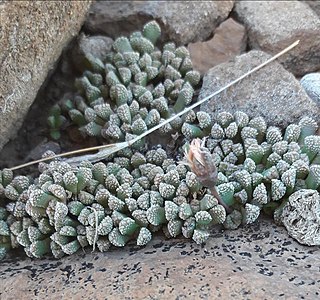
Neohenricia sibbettii, called the coral plant, is a species of flowering plant in the genus Neohenricia, native to South Africa. A succulent, it has gained the Royal Horticultural Society's Award of Garden Merit.

Pleiospilos compactus, called living rock, is a species of flowering plant in the ice plant genus Pleiospilos, native to the southwestern Cape Provinces of South Africa. A succulent, it has gained the Royal Horticultural Society's Award of Garden Merit.

Titanopsis calcarea, commonly called the jewel plant, is a species of ice plant in the genus Titanopsis, native to South Africa. A succulent, it has gained the Royal Horticultural Society's Award of Garden Merit as an ornamental.
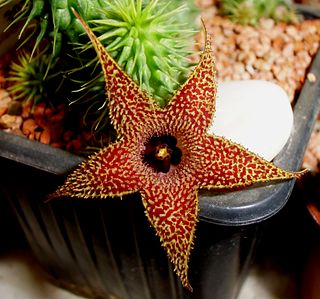
Huernia pillansii, called the cocklebur, is a species of flowering plant in the genus Huernia, native to the Cape Provinces of South Africa. A succulent, it has gained the Royal Horticultural Society's Award of Garden Merit as a hothouse ornamental.
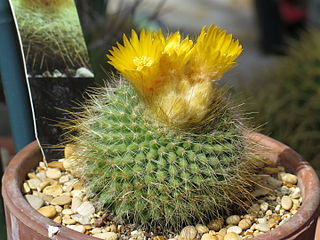
Parodia chrysacanthion, the golden powder puff, is a species of cactus in the genus Parodia, native to northwest Argentina. It has gained the Royal Horticultural Society's Award of Garden Merit.

Echeveria cante, the white cloud plant, is a species of flowering plant in the family Crassulaceae, native to northwestern Zacatecas state in Mexico. A succulent, it has gained the Royal Horticultural Society's Award of Garden Merit.
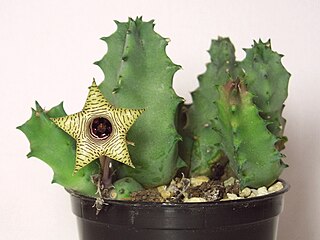
Huernia thuretii is a species of flowering plant in the family Apocynaceae, native to Namibia and to the Cape Provinces of South Africa. A succulent, as Huernia thurettii it has gained the Royal Horticultural Society's Award of Garden Merit.



















